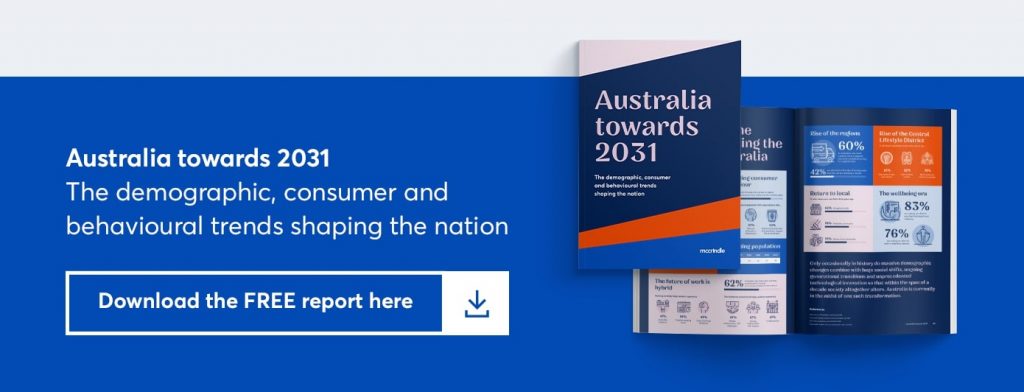By: McCrindle
Over the last hundred years, more and more people have been living in capital cities. It’s the trend of urbanisation.
Yet, here’s the countertrend – people are making the move to regional areas. People are looking for the coastal lifestyle, to make a ‘tree change’ or are looking to move to a more peaceful, serene location. Enter the rise of the regions trend.
While this was a trend we were watching before COVID, since the beginning of the pandemic it is a trend that has been amplified, with people seeking lifestyle areas to live outside of metropolitan areas. During 2020, our research found that 50% of Australians said they were planning on looking for a new home to rent or buy that incorporates more of what they value in the next year or two. Then, in 2021, our research found that 60% of Australians who don’t currently live in a regional area, have considered moving to one.
The regions offer liveability, affordability, and now, employability
While cities are great because they offer economic and social benefits, one of the biggest challenges for many people is affordability – including the cost of housing, the cost of living and even the costs and time expended on commuting. For many people, COVID-19 has provided the opportunity to work-from-home, explore what things they want more of in life and what they want less of.

Prior to the pandemic, many regional areas might have had the lifestyle, but not the employment opportunities. Now that we have decoupled work and the workplace, employability is no longer a barrier to living in a regional area. Many can now take their work with them to a beautiful area. They can work offsite online and get the job done. Even though they aren’t in the office or workplace, staff can still connect with colleagues, suppliers and clients when they need to. Especially if you’re within 2-3 hours commute to the office, then you can do that hybrid work model where you come into the office a few days a week, spend time with the team to make sure that productivity and collaboration remains high, and yet still live in a regional area.
Changes to what we look for in a home
Our homes are going to look different in the future because we are living in a more hybrid world where there is a mix of work and learning from home and the workplace or classroom. People need well-designed spaces that enable them to have privacy, which is quite different to the open-plan trend of recent decades.
Additionally, we’ve seen that future homes will be increasingly smart homes. This means a greater emphasis on having multiple spaces where people can engage in their online digital experiences. From working-from-home to online shopping in an augmented reality within this new Meta era.
The future of cities
Within Australia, states like Victoria and New South Wales have had some of the world’s longest lockdowns. While these measures have kept people safe, people have also been looking to move out of those capital cities. While the number of people moving out of the cities isn’t huge compared to the overall population of over 5 million people in each of these cities, it is nonetheless a trend. Additionally, Queensland has been the benefactor of people moving, especially from places like Sydney and Melbourne.
While people have been leaving these cities in favour of the regions, it is worth noting that there is still good liveability in these global destination cities. These larger capital cities have got a lot right. As people return to the office in a post-COVID world, we’re going to see the trend of CBDs needing to reinvent themselves. In a recent study, 85% of Australians agreed that cities in the future will be the epicentre of arts and culture, as well as the hub of main events (82%).
This means that, if people aren’t all working from large cities anymore, we may see a move away from the CBD (the Central Business District) to the CLD (the Central Lifestyle District), and what we need from our cities might shift. The lifestyle emphasis is what people are looking for and that’s going to be important within both cities and regional areas. Lifestyle design is key. Post-COVID people are a little bit more philosophical as they think about what matters in life. This global pandemic threatened life and forced us to live slow for a bit. Before we speed back up, people are using this time to intentionally plan what they want their life to look like in areas like career, family, home, community involvement, finances and hobbies.

Impacts on the regions
In recent months, we’ve had a returned focus to our local community. The top things that Australians told us that they value more now than they did three years ago is shopping locally, the walkable community and the strong local community. As people look for these things in regional areas, it is putting pressure on the infrastructure of growing regional areas.
If you’ve got a swelling and a rising tide of population, the existing infrastructure needs to be evaluated to ensure that it’s going to remain viable and support the community development.
Things like housing, transport and residential infrastructure will be some of the key challenges and issues. Population growth in these areas needs to be resourced with things like transport, access to schools, health services, , mixed-use commercial spaces, retail hubs, cafes, and restaurants. Cities and regions that become lifestyle areas that offer quality life year-round will be essential to establishing sustainable and thriving communities.
Article supplied with thanks to McCrindle.
About the Author: McCrindle are a team of researchers and communications specialists who discover insights, and tell the story of Australians – what we do, and who we are.
Feature image: Photo by Elle Hughes on Unsplash


